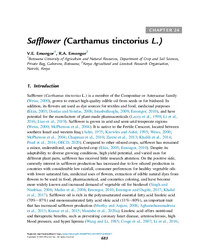| dc.contributor.author | Emongor, V.E. | |
| dc.contributor.author | Emongor, R.A | |
| dc.date.accessioned | 2023-04-20T08:24:46Z | |
| dc.date.available | 2023-04-20T08:24:46Z | |
| dc.date.issued | 2023-01-01 | |
| dc.identifier.citation | V.E. Emongor, R.A. Emongor, Chapter 24 - Safflower (Carthamus tinctorius L.), Editor(s): Muhammad Farooq, Kadambot H.M. Siddique, Neglected and Underutilized Crops, Academic Press, 2023, Pages 683-731, ISBN 9780323905374, https://doi.org/10.1016/B978-0-323-90537-4.00024-7. (https://www.sciencedirect.com/science/article/pii/B9780323905374000247) | en_US |
| dc.identifier.isbn | 978-032390537-4 | |
| dc.identifier.isbn | 978-032390640-1 | |
| dc.identifier.uri | 10.1016/B978-0-323-90537-4.00024-7 | |
| dc.identifier.uri | https://hdl.handle.net/13049/682 | |
| dc.description.abstract | Safflower is an annual underutilized and neglected multipurpose oilseed crop that is drought, heat, cold, and saline tolerant with many uses in food, textile, pharmaceutical, and industrial industries. Renewed interest in safflower cultivation has increased due to its drought tolerance, increased demand for high-quality edible vegetable oil and biodiesel, and consumer preference for healthy oil high in unsaturated fats and low in saturated fats, and natural colorants in food, cosmetics, and pharmaceuticals. The detection of safflower oil as a rich source of essential fatty acids, linoleic (polyunsaturated) and oleic (monounsaturated), has further increased interest in safflower cultivation. Safflower can produce good seed yields in semi-arid and arid regions affected by salinity and reduced rainfall due to climate change. Safflower is a climate-smart crop adaptable to variable environmental growing conditions due to its abundant genetic diversity. Effective implementation of specific support policies in technological inputs, pricing, and marketing of safflower by governments in countries facing water deficit and salinity has significant potential of improving food security, alleviate poverty, and improve incomes and livelihoods of farmers in these countries. | en_US |
| dc.language.iso | en | en_US |
| dc.publisher | Elsevier | en_US |
| dc.relation.ispartofseries | Academic Press;2023, Pages 683-731 | |
| dc.subject | Drought and saline tolerance | en_US |
| dc.subject | Neglected | en_US |
| dc.subject | Safflower | en_US |
| dc.subject | Underutilized | en_US |
| dc.subject | Unsaturated fatty acids | en_US |
| dc.title | Chapter 24 Safflower (Carthamus tinctorius L.). | en_US |
| dc.type | Book chapter | en_US |

